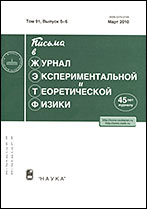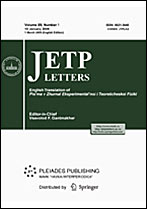|
CONDENSED MATTER
ole of the near-surface region of a substrate in a two-dimensional phase transition leading to the growth of single-layer graphene: the Pt–C system
E. V. Rut'kov, N. R. Gall
Ioffe Institute, St. Petersburg, 194021 Russia
Abstract:
A new approach to the growth and destruction of graphene owing to a two-dimensional first-order condensation phase transition on metals dissolving carbon has been proposed and experimentally tested. It has been shown that this process cannot be correctly described taking into account only intrinsic surface phases: graphene and chemisorbed carbon, as previously proposed for iridium, which is the only metal that does not dissolve C atoms in the bulk. However, the description becomes correct if both carbon atoms on the surface and carbon atoms that are dissolved in the bulk of the metal and are in equilibrium with surface carbon are taken into consideration. A strong correlation between the critical concentrations of carbon on the surface Ns,cr and in the bulk Nb,cr in the phase transition with the formation of graphene islands has been demonstrated by example of the graphene–Pt(111) system. The temperature dependences of Ns,cr and Nb,cr have been determined for the first time in a wide temperature range; in particular, Ns,cr=3.0×1013cm−2 and Nb,cr=3.5×1019см−3 at T=1770 K.
Received: 10.03.2021
Revised: 30.03.2021
Accepted: 01.04.2021
Citation:
E. V. Rut'kov, N. R. Gall, “ole of the near-surface region of a substrate in a two-dimensional phase transition leading to the growth of single-layer graphene: the Pt–C system”, Pis'ma v Zh. Èksper. Teoret. Fiz., 113:9 (2021), 595–599; JETP Letters, 113:9 (2021), 576–580
Linking options:
https://www.mathnet.ru/eng/jetpl6418 https://www.mathnet.ru/eng/jetpl/v113/i9/p595
|


| Statistics & downloads: |
| Abstract page: | 119 | | Full-text PDF : | 12 | | References: | 40 | | First page: | 12 |
|





 Contact us:
Contact us: Terms of Use
Terms of Use
 Registration to the website
Registration to the website Logotypes
Logotypes









 Citation in format
Citation in format 